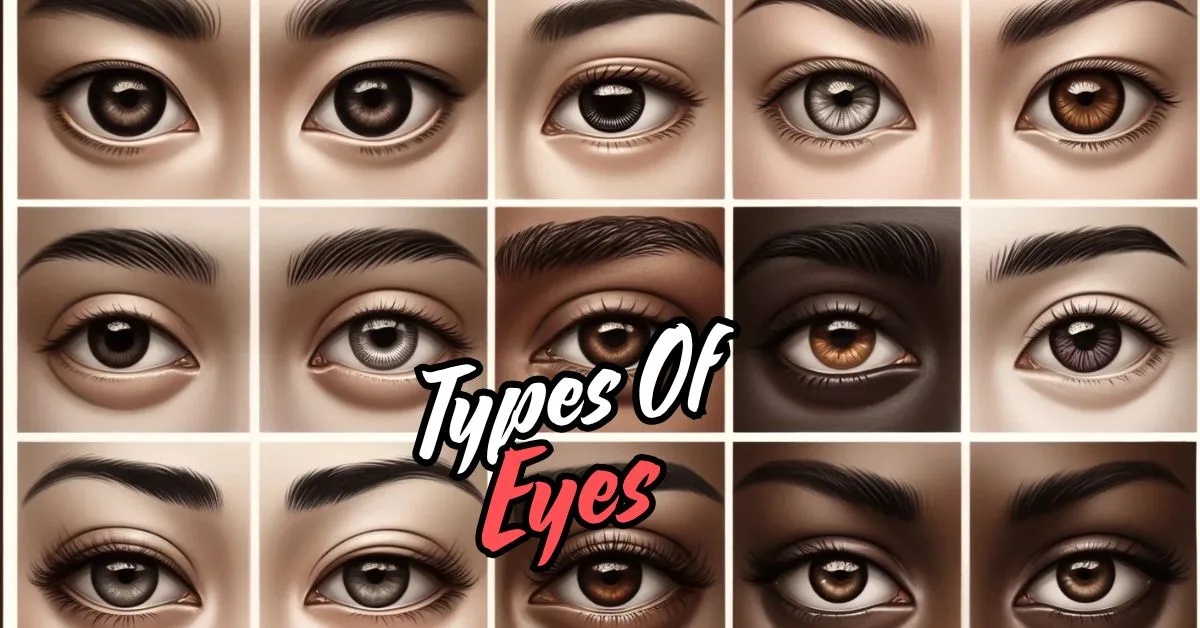Eyes are among the most captivating features of the human body. They allow us to experience the world visually and express emotions non-verbally. The diversity in types of eyes is significant, encompassing various colors, shapes, and conditions. Understanding these differences can enhance our appreciation for human variation and complexity. This blog post delves into the various types of eye colors, shapes, and common eye conditions, providing essential tips for maintaining eye health. By exploring these topics, we can better understand how our eyes function and the importance of caring for them.
1. Types of Eye Colors
Eye color is one of the most distinctive characteristics a person can have. The most common colors include brown, blue, green, and hazel. Brown eyes dominate globally, primarily due to higher melanin levels, which give them a darker appearance. This color is prevalent in many populations, particularly in Asia and Africa. Blue eyes are less common, resulting from a genetic mutation that leads to lower melanin production. People with blue eyes often have lighter skin tones, creating a striking contrast. Green eyes are rarer and intriguing, resulting from a combination of yellow and blue tones. Hazel eyes showcase a blend of colors that can appear to change with different lighting conditions. Genetics plays a crucial role in determining eye color, making it a fascinating subject for study. Two brown-eyed parents can have children with blue or green eyes, highlighting the complex nature of genetic inheritance. Understanding these variations enriches our appreciation for human diversity.
2. The Anatomy of the Eye
The human eye is a complex organ, essential for vision. It comprises several critical parts that work together to enable sight. The cornea is the outermost layer, playing a vital role in focusing light onto the retina. It helps bend light rays, allowing us to see clearly. The iris is the colored part of the eye that controls the size of the pupil, which regulates the amount of light entering the eye. A larger pupil allows more light in, while a smaller one reduces it. The lens, located behind the iris, fine-tunes the focus, allowing us to see objects clearly at varying distances. The retina is a thin layer at the back of the eye that contains photoreceptor cells. These cells convert light into electrical signals, which are transmitted to the brain via the optic nerve. The brain processes these signals into the images we perceive. Understanding the anatomy of the eye helps us appreciate the intricate design of this vital organ. Each component plays a specific role in the overall function, ensuring we can navigate and enjoy our visual world.
3. Eye Shapes: What Do They Mean?
Eye shape is another distinctive feature that varies widely among individuals. Common eye shapes include almond, round, and hooded. Almond-shaped eyes are slightly elongated with a slight upward slant, resembling the shape of an almond. This eye shape is often associated with beauty in many cultures. Round eyes, characterized by their circular shape, can give the impression of youthfulness and curiosity. They may appear larger and convey a sense of innocence. Hooded eyes have a fold of skin that partially covers the eyelid, creating a unique appearance. This shape can sometimes make the eyes look smaller but adds depth to expressions. Beyond aesthetics, eye shapes can influence how we apply makeup and enhance our features. Cultural perceptions of beauty often link specific eye shapes to attractiveness, demonstrating the social significance of eye shapes. Understanding these variations encourages us to appreciate the uniqueness of each individual, promoting a broader acceptance of diverse features. Eye shapes, while often considered purely cosmetic, also carry historical and cultural weight, shaping perceptions of beauty and individuality.
4. Common Eye Conditions and Diseases
Eye conditions and diseases affect millions worldwide, making awareness essential for maintaining eye health. Myopia, or nearsightedness, is one of the most common vision problems. It occurs when the eyeball is slightly elongated or the cornea is overly curved, causing distant objects to appear blurry. Conversely, hyperopia, or farsightedness, results from a shorter eyeball or flat cornea, making close objects difficult to focus on. Astigmatism is another widespread condition caused by an irregularly shaped cornea, leading to distorted vision. More serious eye diseases, such as glaucoma, cataracts, and macular degeneration, can significantly impact quality of life. Glaucoma damages the optic nerve, often linked to increased eye pressure. Cataracts involve clouding of the lens, leading to blurred vision, while macular degeneration affects the retina, impacting central vision. Regular eye examinations are crucial for early detection and management of these conditions. Many eye diseases can be treated effectively if caught early, so understanding risk factors and symptoms is vital. Awareness and proactive care are essential for maintaining vision health and preventing serious complications.
5. Tips for Eye Care and Health
Taking care of your eyes is essential for long-term health and good vision. Simple habits can make a significant difference. First, schedule regular eye exams, especially if you have a family history of eye conditions. Early detection can prevent vision loss and ensure prompt treatment. Eating a balanced diet rich in fruits, vegetables, and omega-3 fatty acids is also crucial for maintaining eye health. Foods like carrots, spinach, and fish provide essential nutrients that support vision. Protecting your eyes from harmful UV rays is equally important; wearing sunglasses outdoors can help shield them from damage. Another critical aspect of eye care is managing screen time. The 20-20-20 rule is a helpful guideline: for every 20 minutes spent looking at a screen, take a 20-second break and look at something 20 feet away. This practice can reduce eye strain and discomfort. Staying hydrated and ensuring adequate sleep are vital for overall well-being and eye health. By adopting these habits, you can significantly enhance your eye health and reduce the risk of developing vision problems over time.
6. Vision Types: How Do They Differ?
Vision varies greatly among individuals, and understanding these differences can foster empathy and awareness. Normal vision is often referred to as 20/20 vision, indicating clear sight at a distance of 20 feet. However, many people experience variations in their visual abilities. Color blindness is a common condition affecting the perception of certain colors, primarily red and green. This condition arises from genetic factors and can affect daily life in various ways. Night vision is another critical aspect of visual perception. Some individuals naturally possess better night vision, enabling them to see more clearly in low-light conditions. This ability can be advantageous for activities such as driving at night. Other factors influencing vision include age, overall health, and environmental conditions. Regular eye check-ups are essential for monitoring changes in vision and identifying potential issues. Understanding the diverse ways people see the world encourages acceptance and support for those who experience vision challenges. Embracing the differences in vision types can lead to greater awareness and a more inclusive understanding of the visual experiences of others.
7. The Role of Technology in Eye Health
In today’s digital age, technology plays a significant role in eye health management. With the increasing use of screens for work, entertainment, and communication, our eyes are subjected to more strain than ever before. This surge in screen time has led to the widespread recognition of conditions like digital eye strain or computer vision syndrome. Symptoms can include dryness, irritation, blurred vision, and headaches.
Fortunately, technology also offers solutions to help mitigate these issues. Many devices now come with built-in blue light filters that reduce the amount of blue light emitted from screens. Blue light can disrupt sleep patterns and contribute to eye fatigue, making these filters a valuable feature. Additionally, software applications are available that remind users to take regular breaks, helping to implement the 20-20-20 rule more effectively.
Wearable technology, such as smart glasses, is also emerging as a way to enhance vision. These devices can provide augmented reality experiences, assist with navigation, and even aid individuals with specific vision impairments. Furthermore, advancements in telemedicine have made it easier for individuals to consult eye care professionals without needing to visit a clinic. This accessibility is particularly beneficial for those living in remote areas or those with mobility challenges.
Staying informed about the latest technology in eye care can empower individuals to take proactive steps toward maintaining their vision. By leveraging these advancements, we can enhance our eye health while navigating an increasingly digital world. Embracing technology as a tool for eye care will be essential in the years to come, especially as our reliance on screens continues to grow.
Conclusion
The diversity of eyes, encompassing various colors, shapes, and conditions, is a fascinating topic that highlights the complexity of human biology. By understanding the different types of eyes, we can appreciate not only their beauty but also the importance of eye health. Regular eye exams, a balanced diet, and protective measures are crucial for maintaining good vision. Awareness of common eye conditions can help in early detection and treatment, ensuring a better quality of life. Embracing the diversity of eye characteristics fosters a greater appreciation for human uniqueness and individuality. Prioritizing eye health through proactive care and informed choices can help everyone enjoy the gift of sight for years to come.
FAQs About Eye Types and Health
What are the most common eye colors?
Brown is the most common eye color globally, followed by blue, green, and hazel.
How can I improve my eye health?
Regular eye exams, a balanced diet, and UV protection are vital for maintaining eye health.
What causes eye diseases?
Genetic factors, age, and environmental influences contribute to the development of various eye diseases.
Are eye shapes genetic?
Yes, eye shapes can be influenced by genetics, similar to eye color.
What is the best way to care for my eyes?
Practice good eye hygiene, limit screen time, eat a healthy diet, and visit your eye doctor regularly.

Alex Taylor is a seasoned writer and editor with over 5 years of experience in digital media. He covers a broad range of topics including tech, culture, fashion, and sports — always with a focus on clarity, relevance, and reader value. Whether breaking down the latest trends or crafting detailed how-to guides, Alex delivers content that informs and inspires.

